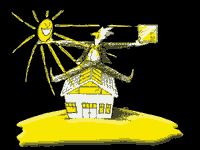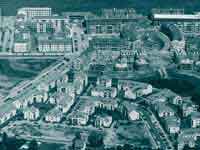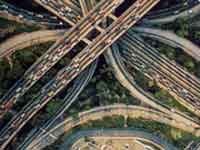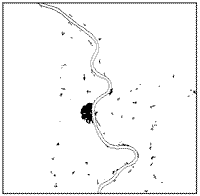| 5. Conclusion
If one were asked to name a desirable state of the contemporary city, following predominant perception it would have to be the pattern of the compact historical city. The present state, the reality of our cities, however, is a different one. The reality of the urban sprawl, the dispersed and low-density development outside of compact urban and village centers along highways and in rural countryside holds our cities tight in its grip. The growth of cities is not a new phenomenon. Ever since man has settled, these settlements have undergone structural change and growth. The phenomenon of urban sprawl which has become more and more apparent since the 1960's is the extreme velocity and unbelievable dynamic of its "outward movement." Noticeable is not a linear growth pattern which successively occupies space but rather the jumping-over and omition of space. This is enabled by ever-faster modes of transportation, especially the increased acceptance of and availability of motorized individual transportation such as the automobile which is capable of conquering great distances so long as the necessary infrastructure is available. The causes of urban sprawl are well-known despite their enormous complexity, as well as the negative effects on all basic aspects of human existence. German cities are close on the heels of America's cities, spilling out into open space. The influence of differences within the context of society on the structure of our cities is not directly verifiable but should be assumed as existent. The discussion of urban sprawl is confined to a professional audience in Germany, generally under the headline of "sustainable development". A broad discussion held in the American media on the other hand shows the increasing influence of "new" media. It is a fact, that information is primarily transmitted via the written word. The influential possibilities of different forms of transferring knowledge which the medium computer has brought into existence (motion pictures, new forms of communication and interaction) remain largely ignored. An interesting point of departure, in order to make the public aware of the problem of urban sprawl, might be for example to show how their own region is subject to change. Especially with the aid of computer-visualization and animation, it would be possible to show how the image of the landscape and settlements in their region change dramatically over a period of time, following small previously unnoticed changes. The possibility of communication that the "new" medium offers may well be its biggest potential. Communication across continental divides. One thing is certain: the problem of urban sprawl is not restricted to the individual cities of two countries. It is as global as the medium internet itself. That may yet be the strong-point: global solutions have to be found in a communal process. Apart from the necessary communication infrastructure, once again the political and social will to change is prerequisite for success.
|
||||||
 |
||||||
 |
||||||
 |
||||||
 |
||||||
 |
||||||